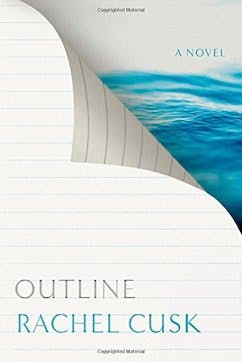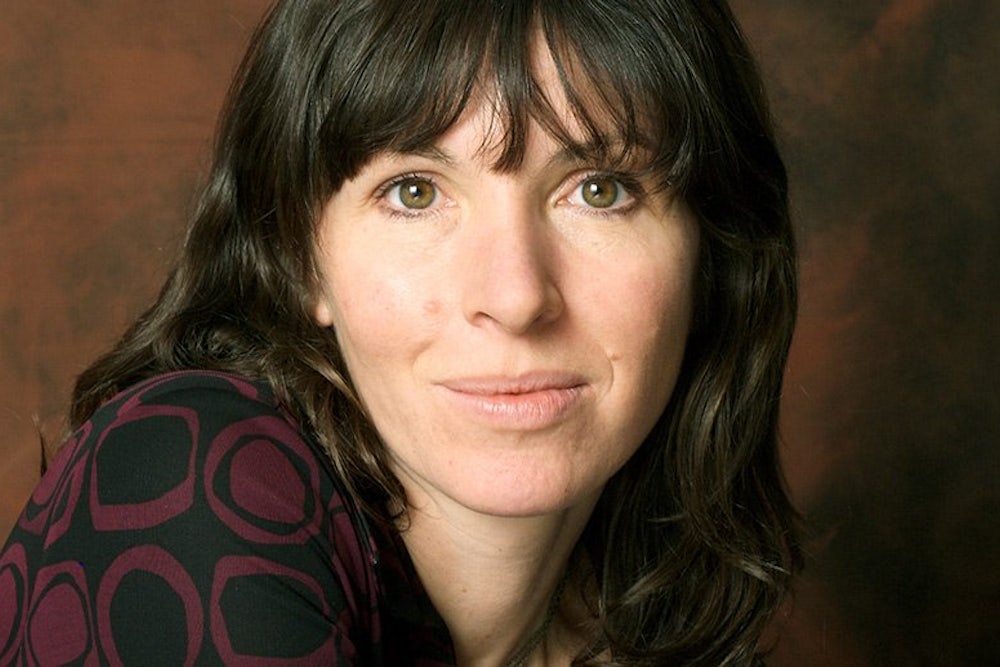The relationship between Rachel Cusk and the English press is like a lousy marriage from one of her own barbed, unsentimental novels. When Cusk first blew onto the scene in the early ’90s with the publication of Saving Agnes, she was a photogenic and brilliant Oxford grad who always sounded a bit depressive in interviews. British journalists—in love with the glamour of privilege, but always suspicious of someone who might not be enjoying it appropriately—responded with backhanded flattery. “The life of Rachel Cusk is not a tale for those of envious disposition,” wrote The Times of London in 1995. When Vogue profiled her around the publication of Saving Agnes, the story began, “Don’t you just hate people like Rachel Cusk?”
About a decade later, the merciless reception of Cusk’s 2001 memoir, A Life’s Work: On Becoming A Mother, was perhaps inevitable. The book itself is merciless, a raw account of Cusk’s ambivalence surrounding the birth of her daughter. Some reviewers found it a welcome contrast to the generally stale writing about motherhood. Others were less generous. “This isn’t what it’s like to have a baby; it’s what it’s like for a depressed and melodramatic novelist to have a baby,” wrote The Sunday Times. A new image of Cusk—the whinging bad mother, the self-pitying artiste—festered in places like the online forum Mumsnet, where Cusk is a beloved target.
Hatred of Cusk really peaked in 2012 with Aftermath: On Marriage And Separation—an elliptical, messy, often frustratingly over-intellectualized memoir about her split from her husband. “It’s not a congenial place, this Cuskland,” The Guardian wrote, “with its low mephitic cloud of complex melancholia”—and that was one of the positive reviews. The Sunday Times’s take—which called Cusk “a brittle little dominatrix and peerless narcissist who exploits her husband and her marriage with relish”— actually won an award for “hatchet job of the year” from the website Omnivore.
There are unfair reasons why English reviewers go after Cusk in such personal terms—class antagonism, mommy-war carnage—and then there are somewhat more understandable ones. Cusk has a deft knack for irritating people, especially in the first person. A piece she wrote for The Guardian on the banality of suburban book clubs is a favorite Mumsnet hate-read. “My interest in books was a little fanatical, perhaps, to be constrained by decorous monthly meetings,” she writes. (One can imagine her poor literary agent passing out quietly in a corner somewhere.) Ever since coming under attack for A Life’s Work, there’s been a defensive quality in her writing that sometimes comes off as precious, a boxer stepping into the ring and shocked, truly shocked, to get punched in the face.
Cusk has frequently pointed out that she’s a writer, not a professional dinner companion. But these two roles are more difficult to separate in her case than in most. Cusk doesn’t write about walrus herders in Chukotka. Even her fiction deals with recognizably Cuskian women, navigating middle-class muddles that are often transparently similar to the ones she describes herself navigating in nonfiction. All these women share the prickly, restless, infinitely self-observing subjectivity that makes Cusk both so hated and so beloved. The existence of this fictional double doesn’t excuse the attacks on Cusk. But it does help explain the complex game of Cusk’s public life: defending herself from others’ perceptions of her character, while spinning highly personal, sometimes very painful and damaging versions of this very character.
The violently negative response to Aftermath, Cusk told the Guardian in 2014, left her in a “total silence.” She wasn’t able to write for years. Both traditional, realist fiction and memoir had failed her, and so she went looking for a new kind of storytelling mode altogether. The result is her new novel Outline, in which the old Cusk story—the old Cusk character—is vitally transformed.

Faye, the protagonist of Outline, is a recently divorced author traveling to Athens for a few days to teach a creative writing course. Although Faye is central, her own story is almost completely excised from the book, which is made up of the stories told to her by people she meets on her trip: a billionaire lunch companion; her neighbor on the flight, a middle-aged Greek shipping heir; another teacher, Ryan; several Greek writers and poets and people working in publishing; a varied group of students ranging from street protesters to housewives; and finally, Anne, a British playwright.
The title of the novel is explained toward the end, in Faye’s conversation with Anne, who has recently endured a terrible series of traumas: Her husband left her, and then she was attacked on the street. Since the attack—a moment when “drama became something real to me”—she has been creatively null. But during her flight to Athens, she has a surprisingly enlightening conversation with a fellow passenger. “He was describing ... what she herself was not: in everything he said about himself, she found in her own nature a corresponding negative. ... [While] he talked she began to see herself as a shape, an outline, with all the detail filled in around it while the shape itself remained blank.” The empty shape, Anne says, “even while its content remained unknown,” gives her “for the first time since the incident a sense of who she now was.” Anne’s story, with its obvious parallels to Faye’s (and Cusk’s) situation, feels like an odd tack-on, a retroactive reader’s guide to the preceding 200-odd pages. But although it’s made overly explicit, the concept of negative identity defines the novel in crucial and illuminating ways.
If Faye is the negative space, then the novel’s quasi-Socratic dialogues construct a very particular outline. Certain themes return again and again: the illusions created by love, whether honesty is possible between men and women, the dizzying shift in perspective that occurs when a relationship ends. Many conversations tug gently at the comforting falsities of marriage. “My wife eyeballs the fellas, when she’s out for the night with her friends,” Ryan, the other writing instructor, tells Faye when she catches him ogling an attractive waitress. “I’d be disappointed if she didn’t. Take a good look, is what I say. ... And she’s just the same—go on, feel free to look.”
In the classroom scenes, Faye and her students debate theories of story, circling around concepts that Cusk has wrestled with her entire career. A teenaged student, Georgeou, argues that “he saw the tendency to fictionalize our own experiences as positively dangerous, because it convinced us that human life had some kind of design and that we were more significant than we actually were.” As Faye asks the students to tell their stories, some respond with catharsis, telling wrenching personal tales. One resists, angrily: “She had been told this was a class about learning to write, something that as far as she was aware involved using your imagination.”
In Cusk’s previous books, the characters’ caged ferocity often propelled the plot, their frenzied, impotent urge for action occasionally springing loose into some unforgivable strike. Maisie, in the suburban- decadence novel Arlington Park, screams at a woman in an SUV, for instance. Outline, by contrast, is anti-action, anti-plot. “I had come to believe more and more in the virtues of passivity,” Faye tells the shipping magnate, “and of living a life as unmarked by self-will as possible.” The inchoate, repressed female yearning that has been so central to all of Cusk’s books, fiction and non, is dispensed with as just another destructive dream. At one point, describing an urge to swim out farther and farther into the ocean, Faye dismisses the feeling as “simply a desire to escape from what I had.” Her decisions in the novel barely qualify as decisions at all. She goes out with the shipping magnate on his boat, for reasons that she’s unsure about, then rejects his awkward advances. When she asserts herself, it’s generally in the role of a critic or a teacher: correcting an interlocutor when he favors his own side in a story; helping her son find his way to school, over the phone from England. She serves as a jaded, clear-eyed—and numbly inert—antidote to illusion: in fiction, in love, in life.
Cusk is one of many novelists who has, in recent years, expressed frustration with the artificiality of fiction. She is an avid admirer of the Norwegian writer Karl Ove Knausgaard, and has, like him, argued that the puppetry of fiction simply can’t encompass real life. (What she actually said in a Guardian interview, with typical Cuskian hauteur, was, “Once you have suffered sufficiently, the idea of making up John and Jane and having them do things together seems utterly ridiculous.”) But in fact, one of the oddities of Outline is the extent to which the book acts as a mini-symposium on the question of reality and illusion, and in that sense ends up feeling very artificial itself. Would so many random Greeks have really come forth with their thoughts on marital illusions during a short trip to Athens? Could her students’ work have so precisely and immaculately reflected Cusk’s concerns about the deficits of fiction? She’s staking claim to unvarnished truth while presenting a very smoothly varnished surface. Outline lacks Knausgaard’s deliberate sloppiness, his “Supermarket Sweep” approach to writing about his own life: everything in, for better or worse.
That said, it’s also much less boring than Knausgaard’s books, and much better written. Cusk almost can’t help what a good storyteller she is, even if she’s attempting something less conventionally “told.” Many of the conversations in Outline form brilliant tiny narratives. One of the best involves a pompous feminist novelist and an anxious editor, both cowed by and resentful of her new success: “Her sufferings—whatever they were—being over she has elected herself a sort of spokesperson for suffering womanhood generally,” the editor says to Faye before the novelist arrives. In another scene, a student in Faye’s workshop tells a terrifying story involving a tiny, horrible dog named Mimi. Overall, the book represents an impressive expansion of Cusk’s voice, achieved through a new minimalist touch. Sometimes this feels stilted, like a reflection of Faye’s emotional deadness, but other times it works well. The more delicate approach makes Cusk a more effective satirist here than in earlier novels, where the scales sometimes felt too heavily tipped against her targets.
In Aftermath, Cusk wrote that after her divorce she had “come to hate stories” like the ones her husband told about her, which to her felt separate from the truth. Throughout her life and work, she goes on to say, she has always struggled with trying to reconcile truth and story, “like the child of divorce tries to reconcile its parents.” It’s understandable, given the narratives people have constructed around Cusk over the past decade, that she would have wanted to hide from story: to shuck it off, lay bare the truth. But in Outline, the stories are the best part: funny, sharp, well-constructed. Cusk hasn’t given up on story at all, she has found a compelling new way to embrace it.
